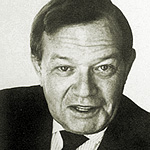What some might call the original British invasion began more than 50 years before the Beatles arrived in America, when a great music man to be, Jule Stein, left his homeland of England with his parents, bound for the United States. The year was 1912, and the young boy who would one day become Jule Styne, Broadway and Hollywood composer extraordinaire, was on his way to America’s heartland of Chicago.
Several years before, the youngster, taken by a rich uncle to the London Hippodrome to see the great Scottish star, Harry Lauder, was so excited by the music that he jumped to the stage and began prancing and dancing about with Lauder. Amused and impressed, the singer advised musical training for the lad, and so it followed after the move to Chicago, the father, Isadore Stein, virtually bankrupted himself on a second hand upright piano. Almost from that moment on, the young Jule took lessons and soon began performing, seldom to ever look back. He often accompanied such stars as Al Jolson, Ruth Etting, Fannie Brice, and Sophie Tucker.
In 1954, tiring of gang warfare, Styne and his wife (he had married six years before) moved to New York, where he took over a vocal coaching business from an ill friend, Al Siegal. Successful as a vocal coach, Styne was soon discovered by 20th Century Fox president, Joseph Schenck, who brought him to Hollywood to work with such stars as Shirley Temple, Alice Faye, Tony Martin, The Ritz Brothers and others in that studio’s stable. From 20lh, he moved on to Paramount Pictures, where he met and collaborated with Frank Loesser on “I Don’t Want To Walk Without You Baby,” which remained for 20 weeks on radio’s “Your Hit Parade.” Styne’s next partner was the already highly successful lyricist, Sammy Cahn (the recently deceased and beloved president of the Songwriters’ Hall of Fame) who co-authored a host of memorable hits, including “Guess I’ll Hang My Tears Out To Dry,” “I Fall in Love Too Easily” and “Time After Time,” all of which were hits for Frank Sinatra.
The team eventually made its way back to New York and Broadway and soon came up with a score for “High Button Shoes,” which ran a respectable 727 performances. Styne, with another collaborator, Leo Robin, next hit paydirt with a musical version of “Gentlemen Prefer Blondes,” which with the song, “Diamonds Are A Girl’s Best Friend,” helped Carol Channing and Marilyn Monroe make musical comedy history.
Later, Styne revived his partnership with Sammy Cahn long enough to write the title song for ‘Three Coins In The Fountain,” which won them an Oscar. Styne and Cahn also produced the hit song, “Its Magic,” for the film “Romance On The High Seas,” which starred Doris Day. Yet another memorable teaming of talents brought Styne together with Betty Comden and Adoph Green for the score for “Peter Pan” and “Bells Are Ringing,” which contained “Just In Time” and “The Party’s Over,” two more great hits.
Other Jule Styne shows continued on the hit path, including titles like “Funny Girl,” “Subways Are For Sleeping,” “Do Re Mi,” “Fade In Fade Out,” “Hallelujah, Baby!” and of course, the incredibly successful collaboration with Stephen Sondheim, “Gypsy.”
Styne received the Kennedy Center Award for Artistic Achievement, and he is an 1972 inductee in The Songwriters Hall of Fame and the Theater Hall of Fame, and is the proud owner of two Grammy awards, a Tony award, an Oscar, an Emmy, the Donaldson Award and The Drama Critics Circle Award.
Jule Styne’s work on the Broadway Show, “The Red Shoes” continued, having written five ballets for this special show with Marsha Norman’s lyrics. If you ask him his favorite composition, he would have quickly told you “I don’t know, I haven’t written it yet.”


